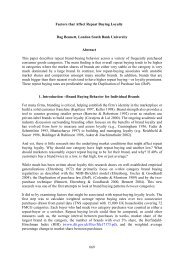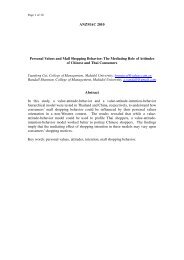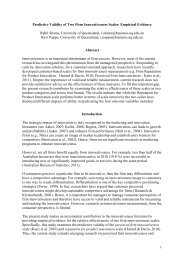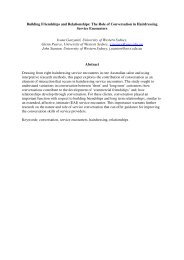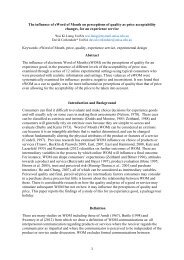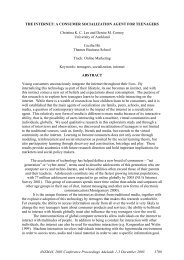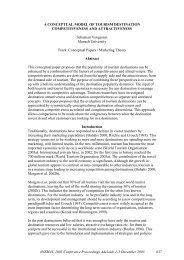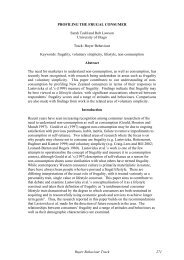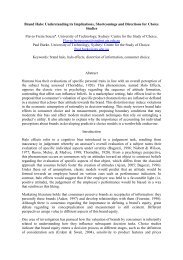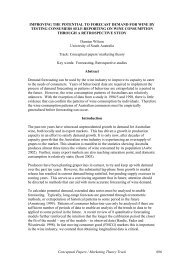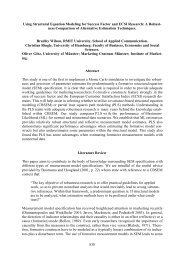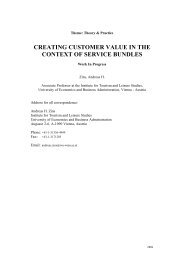amj Australasian Marketing Journal - ANZMAC
amj Australasian Marketing Journal - ANZMAC
amj Australasian Marketing Journal - ANZMAC
You also want an ePaper? Increase the reach of your titles
YUMPU automatically turns print PDFs into web optimized ePapers that Google loves.
Developing Effective Advertising Self-Regulation in Australia:<br />
Reflections on the Old and New Systems<br />
1. Introduction<br />
Whilst Best (1997:p. 223) suggests that only ethical people<br />
can make ethical choices , many cynical observers of advertising<br />
in society would argue that advertisers are increasingly<br />
unethical in their attempts to reach their target markets. The<br />
activity has been described as pervasive (Drake, 1988), intrusive<br />
(Blakeney and Barnes, 1982) and, at times, pernicious. In<br />
the same vein, Mittal (1994) has suggested that the purveyors<br />
of the art have been known to be mischievous in their<br />
commercial role. Globally, we are told, developed and developing<br />
societies are bombarded by several hundred millions<br />
of different advertisements which are published and broadcast<br />
each year (Boddewyn, 1992). On the one hand, these<br />
figures are testament to the importance of this, the most visible,<br />
element of the marketing mix (Boddewyn, 1989:22),<br />
however they can also be viewed as further evidence that<br />
some members of society may need to be protected as some<br />
advertising can be harmful.<br />
A small proportion of advertisements are offensive, false,<br />
misleading, unfair, or socially irresponsible, or they are<br />
perceived as such by the general public. So, when this is the<br />
case, a structure needs to be in place in order to provide<br />
protection to all parties. To complement their legal systems,<br />
developed countries have established programs of regulation<br />
which, in the main, are operated on a self-regulatory basis,<br />
where the industry is responsible for controlling the conduct<br />
of its own members. However, the recent breakdown in<br />
Australia of one of the world s longest established advertising<br />
self-regulatory systems, and the introduction of a new system,<br />
highlights the problems associated with providing effective<br />
Debra Harker, Michael Harker, & Michael Volkov<br />
Advertising Self-Regulation<br />
Abstract<br />
The regulation of advertising is a controversial and difficult process. Over the past three decades, two attempts have been made in<br />
Australia to produce more acceptable ads. This paper reviews these systems using a macro framework for analysis which contextualises<br />
advertising in society. The systems have the fundamental process of handling complaints about advertising in common,<br />
however there are advantages and disadvantages of each and these are discussed. Important insights for the development of regulation<br />
of advertising are presented together with critical implications for the future of the industry.<br />
Keywords: advertising, self-regulation<br />
protection for society from unacceptable advertising (Media<br />
Council of Australia, 1996; Strickland, 1996).<br />
The achievement of acceptable advertising through self-regulatory<br />
systems is a topic that has been debated spasmodically<br />
in leading marketing journals for over twenty years. The<br />
extant literature can be classified into two key streams, the<br />
first provides a significant, although somewhat descriptive,<br />
body of knowledge of advertising self-regulation (ASR) in<br />
general and examines, for example, how various schemes<br />
function around the world (Neelankavil and Stridsberg, 1980;<br />
Miracle and Nevett, 1987; Boddewyn, 1988, 1992). The<br />
second stream is more prescriptive and provides normative<br />
guides for regulators and advertisers to assist in developing<br />
effective ASR programs. Indeed, research studies have<br />
provided seven tests (Moyer and Banks, 1977), five activities<br />
(LaBarbera, 1980), five recommendations (Armstrong and<br />
Ozanne, 1983), six tasks (Boddewyn, 1985), and fifteen rules<br />
(Wiggs, 1992) as normative guides for advertisers in developing<br />
ASR programs.<br />
Despite these research themes, little is known about how<br />
acceptable advertising can be defined and monitored. Thus, in<br />
the overall context of advertising regulation, this article has two<br />
objectives: first, to present and discuss the key variables associated<br />
with acceptable advertising. Second, to use these variables<br />
as a framework to analyse the way advertising is regulated<br />
in Australia — comparing the new administration to the old.<br />
2. Regulation, Self-Regulation and Advertising<br />
The parent body of literature for this research is social control<br />
(Streeck and Schmitter, 1985) and, in particular, regulatory<br />
<strong>Australasian</strong> <strong>Marketing</strong> <strong>Journal</strong> 9 (1), 2001 7



